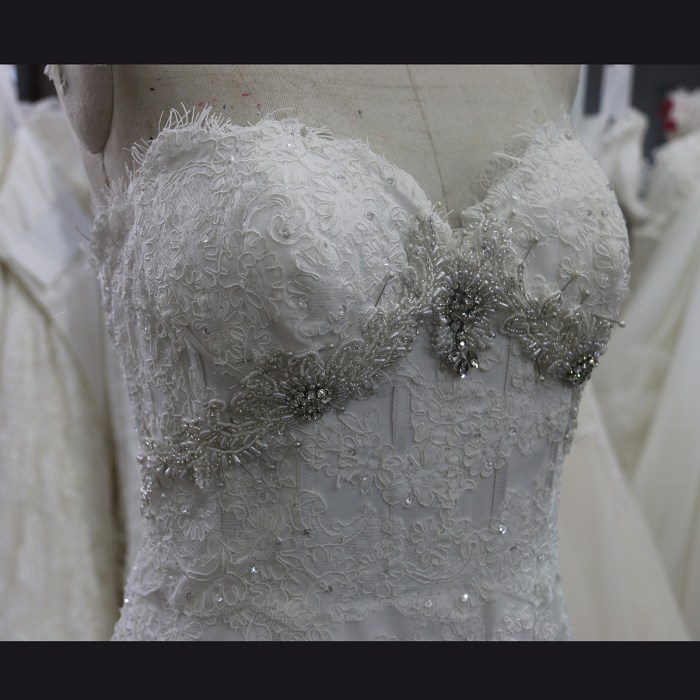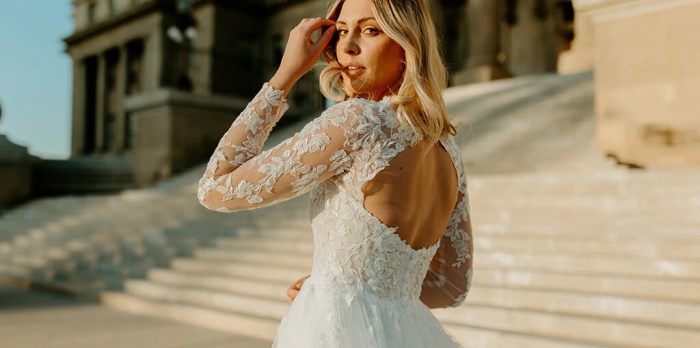Fully Beaded Wedding Dresses A Comprehensive Guide
Design Elements of Fully Beaded Wedding Dresses
Fully beaded wedding dresses are masterpieces of craftsmanship, showcasing intricate designs and luxurious materials. The beauty of these gowns lies not only in the dazzling display of beads but also in the careful selection and execution of various design elements.
Beading Techniques
Several beading techniques contribute to the unique texture and visual appeal of a fully beaded wedding dress. These include hand-sewing, which allows for intricate placement and detailed patterns; machine beading, offering efficiency for larger areas of consistent coverage; and appliqué, where beads are attached to fabric motifs before being sewn onto the dress. The choice of technique significantly impacts the final look and the overall cost.
Bead Shapes, Sizes, and Colors, Fully beaded wedding dress
The diversity of beads available allows for endless design possibilities. Common shapes include round, teardrop, bugle, and seed beads, each offering a unique visual effect. Size variations create depth and texture, while color choices range from classic ivory and pearl to vibrant gemstones and metallic hues. Strategic combinations of shapes, sizes, and colors are key to achieving the desired aesthetic.
Beading Patterns and Placement

Source: weddingbee.com
Beading patterns and their placement profoundly impact the overall aesthetic. Geometric patterns create a structured, modern look, while floral motifs lend a romantic and delicate feel. Strategic bead placement can highlight specific areas of the dress, such as the bodice or the skirt, drawing attention to the desired features. The density of beading also plays a crucial role, influencing the overall visual weight and opulence of the garment.
Comparison of Beading Materials
| Material | Pros | Cons | Cost |
|---|---|---|---|
| Glass Beads | Variety of colors and finishes, relatively affordable | Can be less durable than crystals | $$ |
| Crystal Beads | Exceptional brilliance and sparkle, luxurious look | More expensive than glass beads | $$$ |
| Pearl Beads | Classic elegance, soft luminosity | Can be delicate and prone to damage | $$$ |
| Metallic Beads | Adds shimmer and glamour, various finishes available | Can be heavy and require strong support fabric | $$ |
Fabric Choices and Their Interaction with Beading
The fabric choice is paramount in a fully beaded wedding dress, as it must provide adequate support for the weight of the beads while complementing the overall design. The fabric’s texture and weight directly influence how the beads drape and reflect light.
Suitable Fabrics for Heavy Beading
Strong, supportive fabrics are essential to prevent the beads from pulling or damaging the garment. These include silk charmeuse, heavy silk satin, Mikado silk, and sturdy tulle. These fabrics offer the necessary structure to hold the weight of the beads while allowing for elegant draping.
Fabric Texture and Weight Influence
The fabric’s texture significantly impacts the appearance of the beads. A smooth satin will showcase the beads’ individual brilliance, while a textured lace will create a more intricate and dimensional effect. Heavier fabrics will result in a more structured silhouette, whereas lighter fabrics will allow for a softer, more flowing look.
Comparison of Fabrics with Fully Beaded Designs
Different fabrics interact differently with beading. Here are some examples:
- Tulle: Lightweight and airy, ideal for creating a romantic and ethereal look. The beads will sit beautifully on the tulle, adding sparkle and dimension.
- Silk: Luxurious and fluid, silk provides a smooth surface that enhances the beads’ brilliance. Heavier silks like Mikado offer excellent support for heavy beading.
- Lace: Intricate lace provides a textured base that adds depth and complexity to the beading. The beads can be strategically placed to highlight the lace’s delicate patterns.
The Impact of Silhouette and Beading Density
The silhouette of the dress and the density of the beading work together to create the overall aesthetic. Different silhouettes lend themselves to different beading techniques and densities.
Silhouette and Beading Interaction
An A-line silhouette can accommodate heavy beading throughout the skirt, creating a dramatic and luxurious effect. A mermaid silhouette might feature concentrated beading on the fitted bodice and gradually decreasing density towards the flared skirt. A ballgown silhouette can handle heavy beading, but strategic placement is key to preventing the dress from feeling too heavy.
Beading Density and Visual Weight
Sparse beading creates a delicate and understated look, ideal for a more minimalist aesthetic. Moderate beading provides a balance between visual interest and elegance. Heavy beading creates a dramatic and opulent effect, perfect for a statement wedding dress. The density must be carefully considered in relation to the chosen silhouette and fabric.
Illustrative Sketches
Here are three sketches illustrating variations in silhouette and beading density:
- Sketch 1: A-line silhouette with heavy beading: A classic A-line gown with dense beading covering the entire skirt, creating a cascading effect of sparkle. The bodice features a slightly less dense beading pattern, allowing the skirt to take center stage.
- Sketch 2: Mermaid silhouette with concentrated beading: A figure-hugging mermaid gown with heavy beading concentrated on the bodice and upper skirt, gradually fading to sparse beading towards the train. This highlights the body’s shape while creating a sense of movement.
- Sketch 3: Ballgown silhouette with moderate beading: A full ballgown with moderate beading strategically placed on the bodice and skirt’s upper layers. This creates visual interest without overwhelming the silhouette. The beading focuses on the waistline and neckline, accentuating the body’s shape.
Maintenance and Care of Fully Beaded Wedding Dresses
Proper care is crucial to preserve the beauty and longevity of a fully beaded wedding dress. Improper handling and cleaning can cause irreparable damage to the delicate beadwork and fabric.
Storing and Cleaning
Storing and cleaning a fully beaded wedding dress requires careful attention to detail. Professional cleaning is highly recommended to prevent damage to the beads and fabric. Improper cleaning methods can cause beads to fall off, damage the fabric, or alter the color of the beads.
Potential Risks of Improper Handling
Rough handling, improper storage, and the use of harsh chemicals can cause significant damage. Pulling on the beads, exposing the dress to direct sunlight, or using abrasive cleaning methods can lead to irreparable damage. Always handle the dress with care and follow the professional cleaner’s instructions.
Step-by-Step Storage Guide
- Gently brush the dress to remove any loose dirt or debris.
- Wrap the dress in acid-free tissue paper to protect it from dust and moisture.
- Place the dress in a breathable garment bag or acid-free box.
- Store the dress in a cool, dark, and dry place away from direct sunlight and moisture.
- Avoid hanging the dress, as this can stretch and distort the fabric and potentially cause beads to fall off.
The Cost and Creation Process of Fully Beaded Wedding Dresses

Source: essensedesigns.com
The cost of a fully beaded wedding dress is influenced by several factors, including the complexity of the design, the quality of materials, and the level of craftsmanship involved. The creation process is both time-consuming and labor-intensive.
Factors Influencing Cost
Several factors contribute to the final cost. The type and quantity of beads used, the intricacy of the beading pattern, the fabric choice, the designer’s reputation, and the level of handwork all significantly influence the price.
Time and Skill Involved
Creating a fully beaded wedding dress is a highly skilled and time-consuming process. Hours of meticulous handwork are often required to achieve the desired level of detail and precision. The complexity of the beading design directly impacts the production time.
Cost Comparison: Handmade vs. Mass-Produced
| Factor | Handmade | Mass-produced |
|---|---|---|
| Cost | Significantly higher | Lower |
| Uniqueness | Unique and one-of-a-kind | Less unique, potentially mass-produced designs |
| Quality | Generally higher quality beading and craftsmanship | Potentially lower quality materials and craftsmanship |
| Production Time | Longer lead times | Shorter lead times |
Illustrative Examples of Fully Beaded Wedding Dresses
Fully beaded wedding dresses offer a wide range of styles and aesthetics. Here are three examples illustrating the diverse possibilities.
Example 1: Art Deco Inspired Gown
This gown features a sleek, form-fitting silhouette with a plunging neckline. The beading pattern is geometric, inspired by Art Deco designs, utilizing a combination of crystal and metallic beads for a glamorous effect. The fabric is a heavy silk satin, providing a luxurious drape and showcasing the intricate beadwork.
Fully beaded wedding dresses offer a luxurious, timeless elegance. For brides seeking a similar level of sparkle but with a different silhouette, a fitted style might be preferred, such as the stunning options available when searching for a fitted sparkly wedding dress. Ultimately, both styles offer exceptional shine and glamour, making the choice dependent on personal preference and desired aesthetic.
Example 2: Romantic Floral Gown
This romantic gown boasts a flowing A-line silhouette with a delicate lace overlay. The beading pattern consists of intricate floral motifs, incorporating pearls and seed beads to create a soft and ethereal feel. The base fabric is a lightweight tulle, allowing the beads to drape gracefully.
Example 3: Modern Minimalist Gown
This modern gown features a simple sheath silhouette with strategically placed beading. The beading is concentrated on the bodice and neckline, creating a minimalist yet striking effect. The beading pattern is geometric and abstract, using clear crystal beads to add subtle sparkle. The fabric is a sleek silk crepe, highlighting the clean lines of the dress.
Key Questions Answered
How long does it take to create a fully beaded wedding dress?
The creation time varies greatly depending on the complexity of the design and beading density, ranging from several weeks to several months.
Can a fully beaded wedding dress be altered?
Alterations are possible, but require expert handling due to the intricate beadwork. Consult a professional specializing in bridal alterations.
What is the best way to transport a fully beaded wedding dress?
Use a garment bag designed for delicate items and consider professional transport for long distances to minimize risk of damage.
Are fully beaded wedding dresses suitable for all body types?
While they are stunning, the weight and texture of the beading might not flatter all body types. Consider the silhouette and beading density to find a style that complements your figure.



















